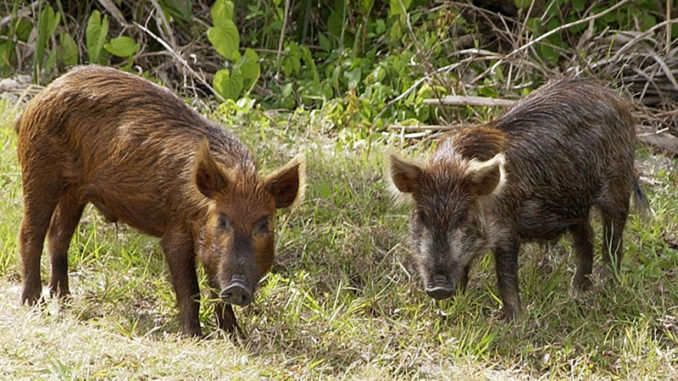
A longtime hunter and trapper, William Everett of Luling is familiar with the problems the wild hog population can cause if left unchecked.
“Everyone knows how prolific and destructive they are,” said Everett. “Oh yeah, they’re a big time issue.”
Feral hogs are known to root up crop fields, compromise water quality and endanger livestock. Boar hogs can become aggressive and have been known to attack humans.
“If you have property anywhere around where there’s deer hunting, you can guarantee hogs are there,” Everett said. “They just tear up the area.”
It’s why Everett has long trapped hogs, and after experimenting with several different traps he has devised one he feels does the best job of controlling the hog population, a 54-foot by 16-inch wire trap that funnels the hogs in and keeps them in — the wire ends are exposed, keeping the hogs from trying to squeeze back out.
“I’ve caught as many as 24 in one (trap),” he said. “(Nobody should) lose sleep or spend cash for sights. Its better spent on traps that will last many years and you will have better control of their population.”
The two most-utilized methods used to control the hog population is trapping and year-round hunting, though Everett believes the first method yields far greater results and efficiency than the second.
He estimates there are 700,000 hogs in Louisiana, as many as 800,000 in Mississippi and close to three million in Texas. But keeping the hogs away and at bay through hunting can be a daunting task for many reasons — simply hunting the hogs, he said, is most likely a sinkhole of time and energy. The hogs primarily appear at night, and there’s no specific time or season to find an elevated number of them. He said hunting hogs may eliminate just two to five percent of them.
“They’re pretty elusive … hard to catch,” Everett said. “You see them mostly in the woodland areas outdoors. Most people hunt during the day when they aren’t normally active. You can spend all night waiting, spend $1,800 to $2,500 on a night scope, just to kill one hog. So it’s not a good hunting sport.”
He said poison baits kill up to 100 percent of them, but concerns over the impact on the environment and other animals renders that a non-option.
It leaves trapping as the best option, he believes. Everett has experimented with it over the years. Some traps are bigger than others, and because hogs often travel in packs, when one is baited others will often join.
“The larger the trap, the more get in,” he said.
Another tip he gave is to place traps in wet areas that hogs frequent.
“High, rocky and dry areas are not used much by hogs,” Everett said. “They are rooters.”





Be the first to comment